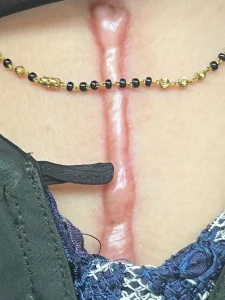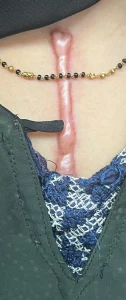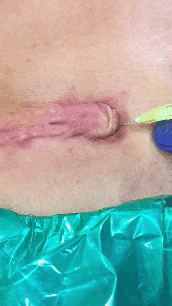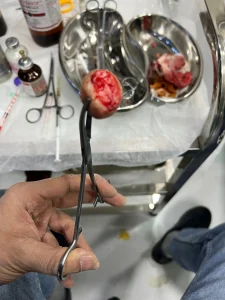About General Surgery
For patients undergoing common general surgery procedures like abscess drainage, sebaceous cyst excision, ear lobe repair, lipoma removal, granuloma excision, keloid removal, or burn treatment, it’s essential to follow specific guidelines for both pre-operative and post-operative care to ensure optimal healing and reduce complications.
Here’s a breakdown of general surgery patient guidelines for each of these conditions:
1. Abscess Drainage
An abscess is a collection of pus caused by an infection, and surgical drainage is often required.
Pre-Operation:
- Antibiotics : If an infection is suspected, patients may be prescribed antibiotics before the procedure.
- Avoid squeezing or manipulating the abscess : This can spread the infection or push bacteria deeper.
- Prepare the area : Keep the area clean and avoid applying any creams or ointments unless instructed.
Post-Operation:
- Wound care : Keep the drainage site clean and dry. Follow instructions on how to change dressings and apply antiseptic ointments.
- Antibiotics : Complete the full course of antibiotics if prescribed.
- Signs of infection : Monitor for signs like increased redness, swelling, warmth, or fever, and contact your surgeon if these occur.
- Pain management : Over-the-counter pain relievers like acetaminophen or ibuprofen may help manage discomfort.
- Avoid tight clothing : Tight clothing or pressure on the area can disrupt healing.
- Follow-up : A follow-up visit may be required to check for healing and ensure the abscess has drained properly.
2. Sebaceous Cyst Excision
Sebaceous cysts are non-cancerous lumps filled with oil and dead skin cells. Removal is usually done for cosmetic reasons or if they become infected.
Pre-Operation:
- Avoid manipulation : Do not attempt to pop or squeeze the cyst, as this can lead to infection.
- Shave the area : If the cyst is on the scalp or another area where hair is present, you may be asked to shave the area before surgery.
- Medications : If an infection is present, you may be given antibiotics before surgery.
Post-Operation:
- Wound care: Clean the surgical site as instructed. Keep the wound covered with a sterile bandage for the first few days.
- Avoid picking at scabs: Let the scab heal naturally to minimize scarring.
- Pain management: Mild pain or discomfort is common; use pain relievers as directed.
- Monitor for signs of infection: Redness, swelling, or pus may indicate an infection.
- Follow-up: A follow-up appointment may be required to ensure proper healing, particularly if stitches are used.
3. Ear Lobe Repair
Ear lobe repair is commonly done for torn or stretched ear lobes, often from wearing heavy earrings.
Pre-Operation:
- Avoid jewelry: Remove earrings or any other jewelry from the area several days before the procedure.
- Clean the area: Gently clean the ear lobe with mild soap and water before the surgery.
Post-Operation:
- Keep the area dry : Avoid wetting the ear for at least 48 hours. Clean the area as instructed by your surgeon.
- Pain management : There may be mild discomfort for a few days; use over-the-counter pain relievers if needed.
- Avoid touching the site : Do not manipulate or touch the ear lobe until the wound has fully healed.
- Avoid re-piercing : Do not attempt to re-pierce the ear until the area has fully healed (usually several months).
4. Lipoma Removal
A lipoma is a benign fatty tumor that can be removed for cosmetic or discomfort reasons.
Pre-Operation:
- Shave the area : The area may need to be shaved to avoid hair interference during surgery.
- Avoid eating or drinking : If general anesthesia is required, avoid food or drink for 8-12 hours prior to surgery.
- Medical clearance : Ensure any other health conditions, like diabetes or high blood pressure, are under control.
Post-Operation:
- Wound care : Keep the area clean and dry. Change bandages regularly as instructed.
- Pain management : Mild pain and swelling are common post-surgery. Use prescribed pain medications or over-the-counter pain relievers.
- Monitor for signs of infection : Increased redness, swelling, or pus discharge may indicate an infection.
- Follow-up : A follow-up appointment may be scheduled to remove stitches (if necessary) and ensure proper healing.
5. Granuloma Excision
Granulomas are small areas of inflammation or tissue that can form after injury or infection, often requiring surgical removal if they don’t resolve on their own.
Pre-Operation:
- Inform your surgeon about other medications : Especially if you’re on immunosuppressive drugs, as these can affect healing.
- Avoid manipulation : Don’t pick at or scratch the granuloma.
Post-Operation:
- Wound care : Follow your surgeon’s guidelines for cleaning and dressing the wound.
- Pain management : Mild pain or tenderness is common after excision.
- Signs of infection : Monitor for signs like increased redness, heat, or drainage from the wound.
- Follow-up : Check-ups are important to monitor for any recurrence of the granuloma.
6. Keloid Removal
Keloids are thick, raised scars that form from abnormal healing after injury. Removal can sometimes be done via excision or laser therapy.

Pre-Operation:
- Discuss scarring risks : Keloid removal carries a risk of recurrence, and your surgeon will discuss ways to minimize this.
- Avoid sun exposure : Sun exposure before surgery can make the keloid harder to remove effectively.
Post-Operation:
- Wound care : Keep the site clean and protected. Use a recommended ointment or silicone sheets to help reduce scarring.
- Pressure garments : In some cases, your surgeon may recommend wearing pressure garments to minimize the risk of the keloid returning.
- Sun protection : Avoid sun exposure, as this can worsen scarring. Use sunscreen on the treated area.
- Follow-up : Regular follow-ups may be needed to assess healing and prevent recurrence.
7. Abscess Drainage
Burns can range from mild to severe, and treatment depends on the degree of the burn.
Pre-Operation ( for severe burns needing surgery ):
- Assess burn severity : Burns are classified as first-degree (mild), second-degree (blistering), or third-degree (full-thickness, requiring surgical intervention).
- Tetanus shot : If the burn is caused by a contaminated source, a tetanus shot may be given.
- IV fluids : Severe burns can lead to dehydration and electrolyte imbalance, so patients may need IV fluids.
Post-Operation:
- Wound care : For burns requiring surgery (e.g., skin grafts), follow strict wound care protocols to avoid infection.
- Pain management : Burns can be very painful, so prescribed pain medications are usually necessary.
- Hydration : Adequate hydration is critical for burn recovery.
- Physical therapy : For deeper burns, physical therapy may be required to prevent contractures and improve mobility.
- Monitor for infection : Signs like increased redness, pus, or fever may indicate infection and should be reported immediately.
- Follow-up care : Burn patients will typically need frequent follow-ups to monitor healing, manage scarring, and prevent complications.
2. Sebaceous Cyst Excision
Sebaceous cysts are non-cancerous lumps filled with oil and dead skin cells. Removal is usually done for cosmetic reasons or if they become infected.
Pre-Operation:
- Avoid manipulation : Do not attempt to pop or squeeze the cyst, as this can lead to infection.
- Shave the area : If the cyst is on the scalp or another area where hair is present, you may be asked to shave the area before surgery.
- Medications : If an infection is present, you may be given antibiotics before surgery.
Post-Operation:
- Wound care: Clean the surgical site as instructed. Keep the wound covered with a sterile bandage for the first few days.
- Avoid picking at scabs: Let the scab heal naturally to minimize scarring.
- Pain management: Mild pain or discomfort is common; use pain relievers as directed.
- Monitor for signs of infection: Redness, swelling, or pus may indicate an infection.
- Follow-up: A follow-up appointment may be required to ensure proper healing, particularly if stitches are used.
3. Ear Lobe Repair
Ear lobe repair is commonly done for torn or stretched ear lobes, often from wearing heavy earrings.
Pre-Operation:
- Avoid jewelry: Remove earrings or any other jewelry from the area several days before the procedure.
- Clean the area: Gently clean the ear lobe with mild soap and water before the surgery.
Post-Operation:
- Keep the area dry : Avoid wetting the ear for at least 48 hours. Clean the area as instructed by your surgeon.
- Pain management : There may be mild discomfort for a few days; use over-the-counter pain relievers if needed.
- Avoid touching the site : Do not manipulate or touch the ear lobe until the wound has fully healed.
- Avoid re-piercing : Do not attempt to re-pierce the ear until the area has fully healed (usually several months).
4. Lipoma Removal
A lipoma is a benign fatty tumor that can be removed for cosmetic or discomfort reasons.
Pre-Operation:
- Shave the area : The area may need to be shaved to avoid hair interference during surgery.
- Avoid eating or drinking : If general anesthesia is required, avoid food or drink for 8-12 hours prior to surgery.
- Medical clearance : Ensure any other health conditions, like diabetes or high blood pressure, are under control.
Post-Operation:
- Wound care : Keep the area clean and dry. Change bandages regularly as instructed.
- Pain management : Mild pain and swelling are common post-surgery. Use prescribed pain medications or over-the-counter pain relievers.
- Monitor for signs of infection : Increased redness, swelling, or pus discharge may indicate an infection.
- Follow-up : A follow-up appointment may be scheduled to remove stitches (if necessary) and ensure proper healing.
5. Granuloma Excision
Granulomas are small areas of inflammation or tissue that can form after injury or infection, often requiring surgical removal if they don’t resolve on their own.
Pre-Operation:
- Inform your surgeon about other medications : Especially if you’re on immunosuppressive drugs, as these can affect healing.
- Avoid manipulation : Don’t pick at or scratch the granuloma.
Post-Operation:
- Wound care : Follow your surgeon’s guidelines for cleaning and dressing the wound.
- Pain management : Mild pain or tenderness is common after excision.
- Signs of infection : Monitor for signs like increased redness, heat, or drainage from the wound.
- Follow-up : Check-ups are important to monitor for any recurrence of the granuloma.
6. Keloid Removal
Keloids are thick, raised scars that form from abnormal healing after injury. Removal can sometimes be done via excision or laser therapy.

Pre-Operation:
- Discuss scarring risks : Keloid removal carries a risk of recurrence, and your surgeon will discuss ways to minimize this.
- Avoid sun exposure : Sun exposure before surgery can make the keloid harder to remove effectively.
Post-Operation:
- Wound care : Keep the site clean and protected. Use a recommended ointment or silicone sheets to help reduce scarring.
- Pressure garments : In some cases, your surgeon may recommend wearing pressure garments to minimize the risk of the keloid returning.
- Sun protection : Avoid sun exposure, as this can worsen scarring. Use sunscreen on the treated area.
- Follow-up : Regular follow-ups may be needed to assess healing and prevent recurrence.
7. Burn Treatment
Burns can range from mild to severe, and treatment depends on the degree of the burn.
Pre-Operation ( for severe burns needing surgery ):
- Assess burn severity : Burns are classified as first-degree (mild), second-degree (blistering), or third-degree (full-thickness, requiring surgical intervention).
- Tetanus shot : If the burn is caused by a contaminated source, a tetanus shot may be given.
- IV fluids : Severe burns can lead to dehydration and electrolyte imbalance, so patients may need IV fluids.
Post-Operation:
- Wound care : For burns requiring surgery (e.g., skin grafts), follow strict wound care protocols to avoid infection.
- Pain management : Burns can be very painful, so prescribed pain medications are usually necessary.
- Hydration : Adequate hydration is critical for burn recovery.
- Physical therapy : For deeper burns, physical therapy may be required to prevent contractures and improve mobility.
- Monitor for infection : Signs like increased redness, pus, or fever may indicate infection and should be reported immediately.
- Follow-up care : Burn patients will typically need frequent follow-ups to monitor healing, manage scarring, and prevent complications.
General Tips for All Surgeries:
- Healthy Diet : Eating a balanced diet with plenty of vitamins (especially vitamin C and zinc) can help speed up the healing process.
- Stay Hydrated : Drinking enough water helps maintain skin elasticity and promotes healing.
- Follow-up Care : Always attend scheduled follow-ups to ensure proper recovery.
- Avoid Smoking : Smoking delays healing and increases the risk of infection and complications.
Each of these surgeries has unique considerations, but these general guidelines should apply broadly.
Consult with us today and get expert guidance and great results !
Frequently Asked Questions
What is Pilates?
Pilates is a form of exercise that focuses on strengthening the core, improving flexibility, and enhancing overall body awareness through controlled movements, proper alignment, and mindful breathing. It can be done on a mat or using specialized equipment.
What are the benefits of Pilates?
What are the benefits of Pilates?
Pilates offers numerous benefits, including improved core strength, better posture, increased flexibility, enhanced balance, reduced risk of injury, and support for rehabilitation and pain management. It also promotes mindful movement and overall fitness.
Who can do Pilates?
Pilates is suitable for individuals of all ages and fitness levels. Whether you are a beginner, an athlete, recovering from an injury, or seeking general fitness, Pilates can be adapted to meet your needs and goals.
Do I need any prior experience to start Pilates?
No prior experience is necessary to start Pilates. Our certified instructors will guide you through the basics and create a program that matches your fitness level and goals. Beginners are welcome and encouraged to join.
What can I expect during a Pilates session?
During a Pilates session, you will engage in a series of exercises that focus on controlled movements, proper alignment, and mindful breathing. Sessions may include mat work or exercises on specialized equipment like the reformer, cadillac, and chair. Your instructor will provide personalized guidance and adjustments.




